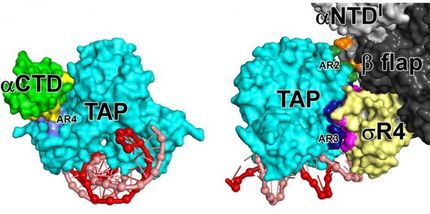Cell growth regulates genetic circuits
Max Planck researchers discover an explanation for different growth rates of genetically identically cells
Advertisement
Genetic circuits control the activity of genes and thereby the function of cells and organisms. Scientists from the Max Planck Institute of colloids and Interfaces in Potsdam and the University of California at San Diego have shown how various genetic circuits in bacterial cells are influenced by growth conditions. According to their findings, even genes that are not regulated can display different activities - depending on whether they are translated into proteins in slow- or fast-growing cells. The results provide researchers with new insights into gene regulation and will help them in the design of synthetic genetic circuits in the future.
Control circuits do not only exist in CD players, coffee makers, or cars, but also in living cells - in this case as "genetic circuits". They consist of a network of different genes which can mutually stimulate or inhibit each other. With the help of these circuits, a cell can switch genes on or off and thus control what proteins it produces. However, genetic circuits also depend on the functioning of the cell as a whole to provide sufficient resources needed for building proteins. For example, the standard laboratory bacterium, Escherichia coli, can adjust its generation time to anywhere between 20 minutes (under optimal conditions) and several hours (e.g. when food is scarce). The change in generation time or growth rate is accompanied by changes of almost all properties of the cells such as their size and their chemical composition.
Protein concentration of unregulated genes decreases at faster growth
By combining theoretical circuit models and experiments with simple synthetic circuits in bacteria the scientists demonstrated that growth rate decisively influences the activities of genes and thus genetic circuits. "We wanted to know how the activity of a hypothetical gene that is not regulated at all would depend on the growth rate of the bacteria. This dependence needs to be taken into account when interpreting changes in gene expression in experiments," says Stefan Klumpp, a Research Group Leader at the Max Planck Institute of Colloids and Interfaces in Potsdam.
Changes within the cell affect protein concentration in various ways. For example, in faster-growing cells more RNA polymerases are available for the transcription of the gene, so the gene is read out more frequently. But there is also less time to accumulate the protein before the next cell division. In addition, faster-growing cells are bigger, so making the same number of protein molecules amounts to a smaller concentration. Assembling all that information in their model, the researchers were able to predict how the protein concentration would depend on the bacterial growth rate. What they discovered was that protein concentration decreases at faster growth rates - a result that matched well with experimental data for unregulated genes.
That the activity of genes and genetic circuits depends on how fast the cells grow makes life more complicated for scientists interested in quantitative characteristics of genetic circuits. Different quantities used to characterize the activity of a gene such as its mRNA and protein concentrations depend on the growth rate in different ways. "For example if the concentration of a particular mRNA is increased by a factor 3 in one condition compared to another, this would usually be taken as a solid indication that the gene is up-regulated", Stefan Klumpp explains.
"But if the cells with the higher mRNA level also grow faster, they could even have a smaller concentration of the corresponding protein." Changes in protein concentration are not necessarily a consequence of regulated gene expression. Such changes can also be the result of a slowdown or acceleration in cell growth.
Feedback between regulated genes and cell growth
The study also shows how such growth effects interact with gene regulation. For example, protein concentration can be made independent of the growth rate if the gene is controlled by negative feedback: Negative feedback stops synthesis of the protein when a certain desired concentration is reached. If the cell continues to grow, protein concentration is initially decreased, so that further protein is built up until the desired concentration is achieved.
Growth effects can also provide a feedback mechanism if cell growth depends on the concentration of a protein, which in turn depends on the cellular growth rate. If, for example, a high concentration of a certain protein inhibits cell growth while at the same time slow-growing cells are producing more of this protein (positive feedback), one part of a population of genetically identical cells may grow faster than the rest. This is only due to the fact that a protein inhibiting cell growth is more frequently produced in some cells than in others. This leads to a slowdown of growth of these cells, which in turn increases the protein concentration, resulting in a further slowdown of growth.
Researchers believe that these growth effects may be actively used in nature and could possibly even be beneficial for bacteria. When bacteria acquire new functions such as new metabolic abilities or tolerance to antibiotics, growth effects may regulate such functions without direct gene regulation. This could serve as a base from which a regulatory circuit may evolve later.
Original publication: Stefan Klumpp, Zhongge Zhang, Terence Hwa; "Global growth-rate dependent effects on gene expression in bacteria"; Cell 2009, 139, 1366-1375.

























































